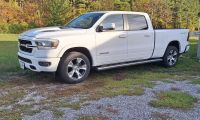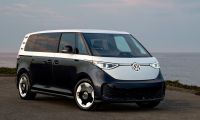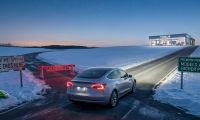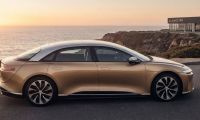Here’s the thing. As an automotive journalist, I have a tendency to gravitate to the technical, mechanical and safety side of newly released cars, trucks, and occasionally motorcycle. If I was to limit this introduction to Arcimoto’s technical and safety features, the article wouldn't run long enough to catch Google’s Bot, you’d never see it!
By today’s auto manufacturing R&D and production standards, the 8th generation Arcimoto SRK, while very cool, in an open vehicle sort of way, is as bare-bones-basic as to airbag compliance, accident preventive measures, adaptive cruise control, electronic assisted ABS brakes, center stack accessed touchscreen monitor connectivity, and “smart wheel,” as it can get. It offers none of the aforementioned, and in fact, is not classified as a car. As an automotive purist, I like that! I like driving...
Affordable, fun, practical, renewable, 70 to 130 miles between charge cycles
Reality check: The majority of Americans drive less than 24 miles per day. Don’t ask me for a source, I read it somewhere, and then went out on a two day run in a Soul EV and qualified the statement. Eugene, Oregon based Arcimoto Electric is betting on this factoid, while presenting a very transformable 3-wheel, cage enclosed, motorcycle handlebar directed electric trike.
I’ve been following Mark and the Arcimoto 9-year development story for several years, and finally nailed down a test drive in early February with Arcimoto P.R. guy Eric Fritz firmly planted on the back seat -- a comfortable seat at that.
Forget what you think you know about 3-wheelers
After scooting onto the car-like seat, and fastening the double shoulder harness and seatbelt, (this is an open vehicle) I released the parking brake (production model will be electric) and pushed the thumb knob to the forward drive position. I then cautiously twisted down on the motorcycle style throttle grip, while easing Arcimoto onto the street -- it was surprising agile yet stable, exhibiting minimal side roll, descent suspension dampening, and civility of ride. Within minutes, driving Arcimoto became second nature.
Our test mule wasn’t equipped with steering dampers or power assist, both are planned for the production model. Yet steering was easy and intuitive, for this seasoned motorcycle rider. The single 70 horsepower electric motor pulled with conviction as we headed up the rather beat-up streets of Eugene. Heading for the only true uphill in town, Skinner’s Butte, I was mentally prepared for performance related disappointed -- I wasn’t. I like the instant-on torque of the near silent electric motor. Cool stuff!
Keeping it simple
The only instrumentation noted here was an electric range minder, and speedometer. The turn signals and headlight switch is accessed via standardized motorcycle grip controls -- they work! I further noted twin stereo sound speakers and a smartphone mount, indicating the near future pairing ability of one’s phone for navigation, communication and entertainment.
As I twisted my way up the steep inclined road to Skinner’s butte, I listened to my thoughts scream “why not,’ and what if? In common thought that drove the initial advent and development of Mark Frohnmayer brain child. For me, I’d personally opt for the enclosed version, or perhaps the delivery Arcimoto, as the bitter cold fog of the February afternoon reminded me of the downside of owner-air transportation. Nonetheless, I like the low center of gravity handling feel, and simplicity of design of Frohnmayer brainchild.
.
The aerodynamic windscreen effectively deflected the cold rain and winds of February
Coming back to reality as I dropped back into Eugene, from Skinner’s Butte scenic overview, I grabbed a handful of regenerative braking, and then discovered no less than 93% remaining on the electric charge range minder. We’d effectively driven across town, climbed the highest hill in the city, returned to the shop, and had enough range to drive 60 miles -- there remained no question in my mind as to the commuting viability of Arcimoto.
It’s fun, easy to operate, can be easily charged at home in a matter of hours, and is slated for 2017 production at an estimated base model MSRP of $11,900. You will find more information on Arcimoto here.
Here’s the bottom line
I can’t count one successful new car-brand roll out, other than Tesla, in decades. The hurdles as to EPA safety compliance, fuel emissions, capitalization, manufacturing and distribution, is a daunting task. Arcimoto follows a path blazed by experimental aircraft builders, and kit car builders of the last century. The key to market success here is multi fold: Arcimoto is classified as a motorcycle, yet will not require a motorcycle operating license, or helmet in certain jurisdictions, thus offering this simplified form of electrified transportation to the driving masses a viable venture.
Furthermore, auto-safety mandates do not fall under the category of motorcycle, although many modern 2-wheel offerings come equipped with ABS brakes, traction control and airbags. Perhaps Arcimoto will offer similar features in the not too distant future.
As to weatherization: Yes, I believe an enclosed model offering to be a must for Arcimoto to gain a market foothold. Looking to Arcimoto’s home website, soft and hard sided doors and body panels, a delivery model, a windshield defroster and heated seat may be available as a consumer installed option. I like the concept and look forward to Arcimoto SRK coming to market in 2017. The initial estimate of the Arcimoto body shell is $3,000.(subject to change) Hopefully, my new friends in Eugene will be able to market a finished, enclosed electric 3-wheeler for under $15,000 -- the price of a used Nissan Leaf.












Comments
How about a top covered one.
Permalink
How about a top covered one. How much will it cost and when will it be ready?
Thank you,